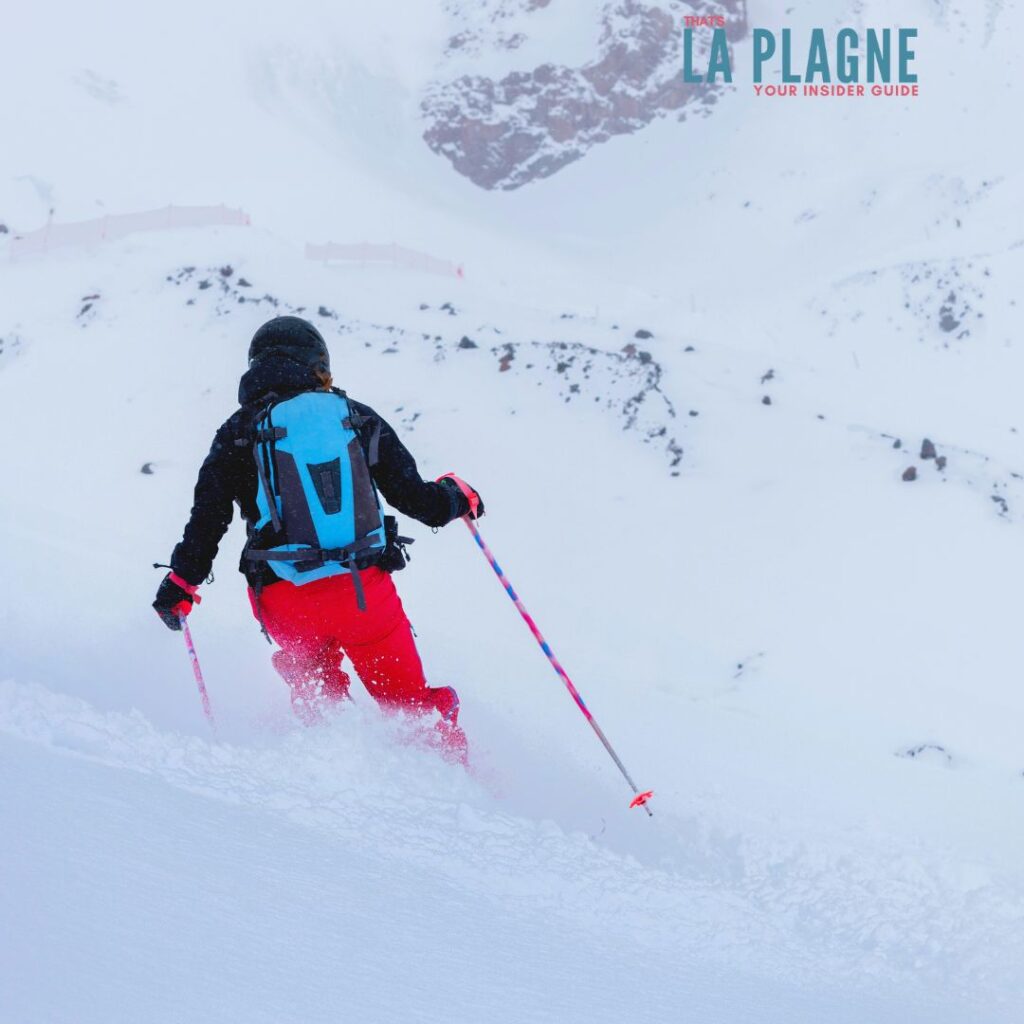That's La Plagne
Skiing in Poor Visibility: Top tips for skiing safely

Join the inside track to get the story first from La Plagne.
The Challenge of Poor Visibility
Skiing in low visibility conditions, whether due to fog, snowfall, or overcast skies, requires additional precautions. The limited visibility can pose challenges, but with the right gear and guidance, you can turn it into an opportunity for a unique skiing experience.
As a ski mum living in La Plagne, I have to be honest, if the weather isn’t bluebird skies, I’m not super motivated to head out. But my kids love it! And when we head out when it’s snowing and ski in poor visibility, it’s often some of the most fun we have. The pistes are often empty, and the snow is fresh underfoot! It’s not the time to explore new areas, but it’s a great opportunity to mess around and have some family ski fun!
So, here are my top tips for making the most of skiing with your family when the visibility isn’t great.
Ski Safety Rules
Before I hand over the ten tips for skiing in poor visibility, the first thing you need to do is make sure you are familiar with the basic ski safety rules of the pistes. This is comparable to the rules you learn to drive safely. The Piste X Code is the perfect tool to help educate yourself and your kids about having fun whilst skiing safely. To find out more, check out this popular post about ski safety and the Piste X Code.
1. Choose High-Visibility Gear
There’s lots of things you can do to help improve yours and your families’ visibility when you’re skiing on the slopes. They don’t have to cost a fortune and actually, your kids will have great fun helping you kit them out correctly.
Bright and Contrasting Colours: Opt for ski outfits in bright and contrasting colours. This not only makes you more visible to others on the slopes but also helps your skiing companions keep track of your movements.
Reflective Elements: Look for gear with reflective elements. These elements catch and reflect light, making your ski kids stand out even in low-light conditions.
LED Accessories: Consider adding LED accessories to your outfit. LED lights on your helmet, goggles, or clothing can make you highly visible in low-light situations.
Helmet with Visibility Features: Invest in a helmet with built-in visibility features, such as a bright colour. This adds an extra layer of safety, especially when skiing in areas with poor visibility.
However, the cheapest way to do this is to get a helmet cover for your kids helmets. This is much more practical, especially if you are renting ski equipment and ski helmets for your family. My 2 kids have a blue monster and a yellow giraffe cover and we make it into a game if or when they need to wear them.
2. Use the right goggles and lenses
Look for goggles with Anti-Fog Technology. Poor visibility often comes with humidity and fog. Choose goggles with anti-fog technology to maintain clear vision and enhance your ability to navigate the slopes.
Next comes the lens quality and colour. Opt for goggles with lenses designed specifically for low-light conditions. Yellow or rose-tinted lenses enhance contrast, making it easier to distinguish features in flat light. Investing in quality goggles tailored to these conditions is a small step that can greatly enhance your skiing experience.
3. Stay Informed About Weather Conditions
Before hitting the slopes, check the weather forecast to anticipate the day's conditions. Poor visibility is often associated with adverse weather, such as fog or snow. Staying informed allows you to prepare appropriately and adjust your skiing plans accordingly.
This is when using a ski resort’s local webcams is a great idea to see the different conditions in different areas around the mountain. This is a great article about why webcams are great for making the most out of your ski days, from finding the sun to avoiding the ski lift lines!
4. Ski with other people
In challenging visibility conditions, skiing with a buddy or a group of friends is a smart move. Stay close to each other, communicate effectively, and use each other as reference points.
Make sure you are of similar ski abilities and that you trust the skiers you are with. To keep having fun, it’s important that you can all ski safely together, and that relies on having confidence in one another.
5. Keep a Safe Distance
Reduced visibility means longer reaction times. To mitigate the risk of collisions, maintain a safe distance from other skiers and obstacles. Give yourself extra space to react and manoeuvre safely, especially when skiing in crowded areas.
6. Stick to familiar terrain
Stay on Designated Trails. Stick to marked ski trails and avoid venturing into off-piste areas during poor visibility. Familiarity with the terrain is crucial when the landscape is not easily visible.
7. Stay on pistes & follow the markers
Trail markers, poles, and on-slope signage become invaluable guides when visibility is poor. Pay close attention to these indicators to stay on designated paths. Trail markers are strategically placed to guide skiers through challenging conditions, ensuring a safer and more enjoyable experience.
8. Slow Down!
Reducing your speed is a simple yet effective strategy in low-visibility situations. Skiing at a slower pace gives you more time to react to changes in the terrain and the actions of other skiers. It's a proactive approach to maintaining control and safety on the slopes.
9. Use Peripheral Vision
In poor visibility, using your peripheral vision becomes crucial. Turn your head regularly to scan your surroundings and detect changes in the terrain or the presence of other skiers. Relying on your peripheral vision enhances your situational awareness and overall safety.
If you are a ski parent, heading out with your kids, you’ll already be familiar with this and the idea of scanning the pistes, crowds and keeping one eye on the kids at all times!
10. Stay Flexible with Plans
Finally, be prepared to adapt your plans based on the evolving weather conditions. Poor visibility may impact your original skiing itinerary, so stay flexible. If conditions worsen significantly, consider taking breaks in designated rest areas until visibility improves.
There’s always time for a hot chocolate on the mountain!
This blog post will give you some tips on how to keep an eye on the weather forecast in La Plagne.
That’s La Plagne and how to ski safety in poor visibility
Skiing in poor visibility requires a combination of preparedness, caution, and adaptability. By following these ten essential tips, you can confidently navigate the slopes even when the weather poses challenges. Prioritise safety, stay informed, and embrace the unique experience of skiing in a winter wonderland, no matter the visibility conditions.
If you're skiing in La Plagne, then head over to my blog post on where to ski in La Plagne in poor visibility for more top tips.
See you on the slopes!


